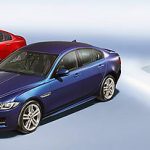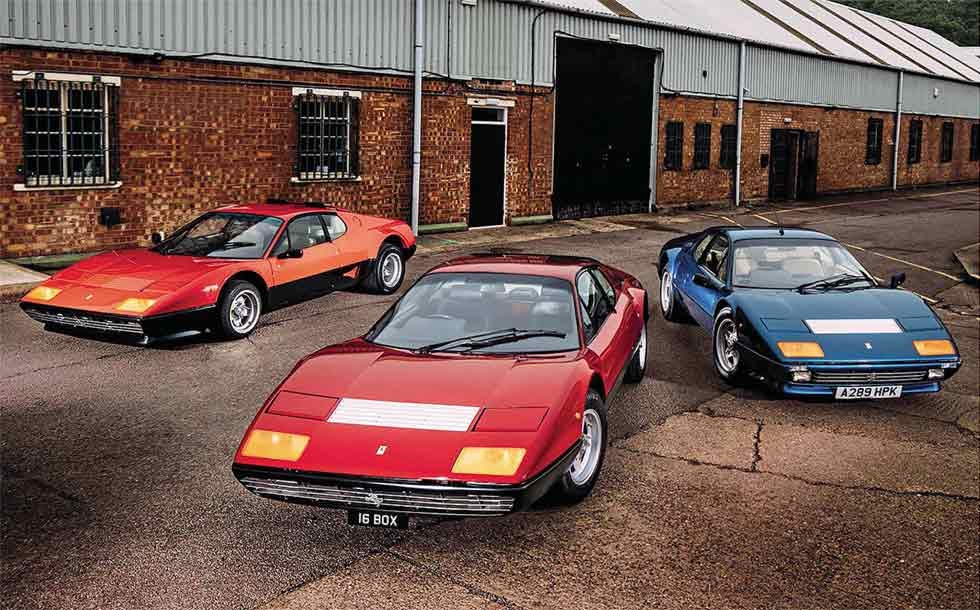
Boxing Clever. The Berlinetta Boxer is one of the great unsung Ferraris. We sample the first and last of the breed – and an ‘inbetweener’ with a few special tweaks. Words John Simister. Photography Malcolm Griffiths.
FERRARI’S BRILLIANT BOXERS BB celebration: we drive first & last
COVER STORY Berlinetta Boxer celebration The BB has a reputation for being a handful, and it’s often overshadowed by the Daytona. Time to re-evaluate Ferrari’s first mid-engined supercar, reckons John Simister.
BB Under the Skin Boxer stripped to the bones. The first right-hand-drive 365 BB in the UK is currently being restored. Very slowly…
Boxers at Le Mans. Tales from the French classic The Berlinetta Boxer wasn’t just a road car. Mark Hales describes driving a BB LM…
The Berlinetta Boxer. Ferrari’s first genuine, full-fat, range-topping supercar, if you take the purist view that a supercar requires an exotically mid-mounted engine with a lot of cylinders, a hefty capacity and monstrous power. It’s strange, then, that the BB is something of a forgotten Ferrari, a side-road off a highway trafficked by V12s and V8s.

It shouldn’t be. The Boxer is a charismatically mad machine. Bad, too, if its reputation is to be believed. Place the engine on top of the gearbox, the pundits reckoned, and the resulting high centre of gravity would surely make an already tail- heavy car into a tail-snapping monster. But that was why the Boxer has, obviously, a low-built ‘boxer’ engine. It’s a flat-12, the first roadgoing example of the type and, as it turns out, the only example if you view its evolution into the Testarossa motor as fundamentally the same unit bar valve-count and camshaft drive details.
There are three phases of Berlinetta Boxer, progressively more house-trained but never any less captivating. We have one of each here, the BB story from start to finish, and their differences are significant. That’s especially true of the middle car of the three, the bright red 512 BB, which has gained during its life an ‘LM pack’ for its engine and a set of wider wheels, dramatically so at the back, to sit beneath wide-arched front and rear clamshells by Koenig, a prolific Ferrari-modifier in the 1970s and 80s.
Each of these cars has its own story to tell, but first comes the bigger picture. Enzo Ferrari had long been sceptical about mounting a 12-cylinder engine in the middle of a road car, despite obvious critical acclaim for the designs of his Lamborghini rival and long experience of racing Ferraris with mid-mounted V12s. But with the 365 GTB/4 Daytona nearing the end of its production life, his engineers considered the idea a new.

Ferrari had committed itself to flat-12s for Formula 1 in 1970, having experimented with the design since creating a 1.5-litre example in 1964. So the idea of using a flat-12 in its new mid-engined supercar, the 365 GT4 BB, was hailed as highly glamorous on the new car’s unveiling at the 1971 Turin show. Its capacity (365cc per cylinder), and indeed its pistons and connecting rods, were shared with the Daytona but the rest of the engine was new.
It sat in a body designed by Pininfarina, Ferrari’s usual shaper of external forms, with a restrained crispness that has not only aged very well but emphasises how cluttered, contrived and oversized today’s Ferraris (and most rivals) have become. Pop-up twin headlights and the world’s largest indicator lenses occupied the low, flat nose. The body’s black lower half gave a taste of a concept car. At the tail, the two groups of three round tail-lights were echoed by the triple tailpipes on each side, engine visible through the slats on the flat rear deck above, spoiler-like crossbar joining the tops of the buttresses beyond. The Boxer looked fantastic.
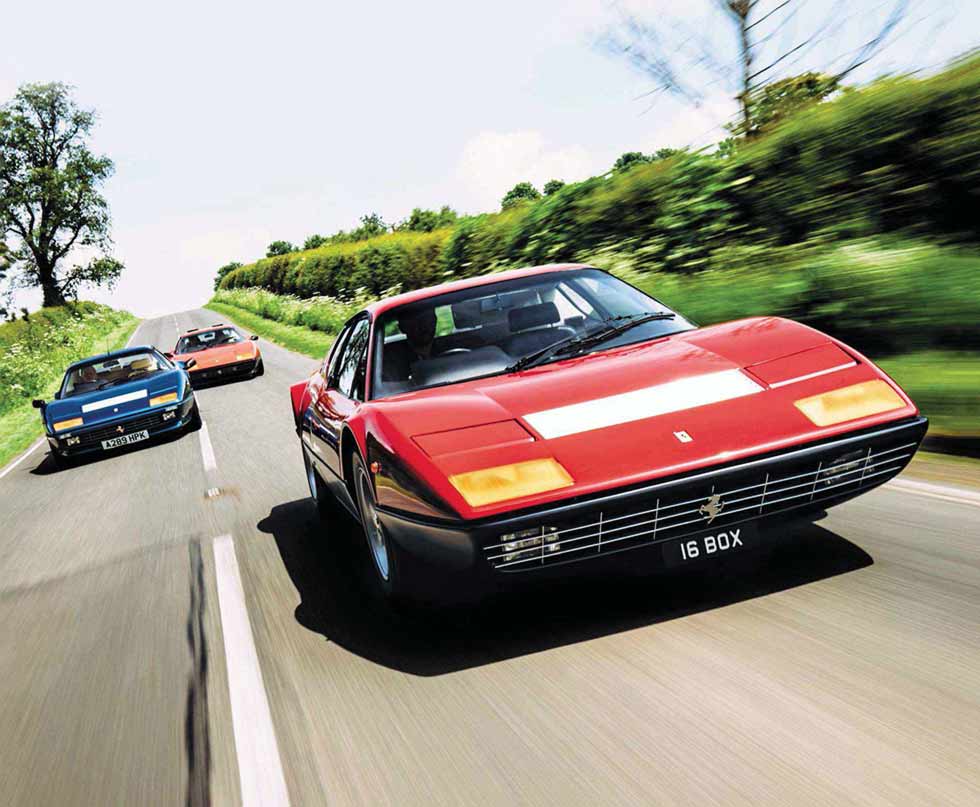
Two years later, the 365 BB went on sale. Its 4390cc promised anything between 344 and 380bhp, depending on who you believed, along with a 5.4sec 0-60mph time and top speed of 175mph, or even 180mph – these speeds making the assumption that the engine would pull peak- power revs in fifth gear, which might or might not have been possible.
Verifying such claims independently was always a problem with a Ferrari, the maker and the concessionaires famously unwilling to allow performance testing by magazines, but Motor did eventually manage to score a 365 BB for road test.
It recorded a more believable 6.5sec to 60mph, but not a top speed. It also recorded an overall fuel consumption of 11.1mpg. A lot of fuel was sucked through those four triple-choke Weber 40 IF3s.
After only 387 cars had been built, 85 of them in right- hand drive, the Boxer transmuted into the 512 BB in 1976. Had Ferrari continued with its model designation according to individual cylinder capacity it would have been the 412 BB, but instead the name referred simply to five litres (actually 4942cc) and 12 cylinders. Power was up, possibly – 360bhp is the consensus – while torque was up a bit more. So was weight, thanks partly to air-conditioning and wider rear wheels, which meant that performance stayed more or less as it was.
Also new, and significant, were a twin-plate clutch to give a lower effort at the pedal, and a dry-sump lubrication system to cure reported oil-surge problems – but not to lower the engine, because the gearbox was in the way. NACA ducts in the sills and a front bib spoiler were obvious visual changes, along with four rear light lenses and tailpipes instead of six of each.
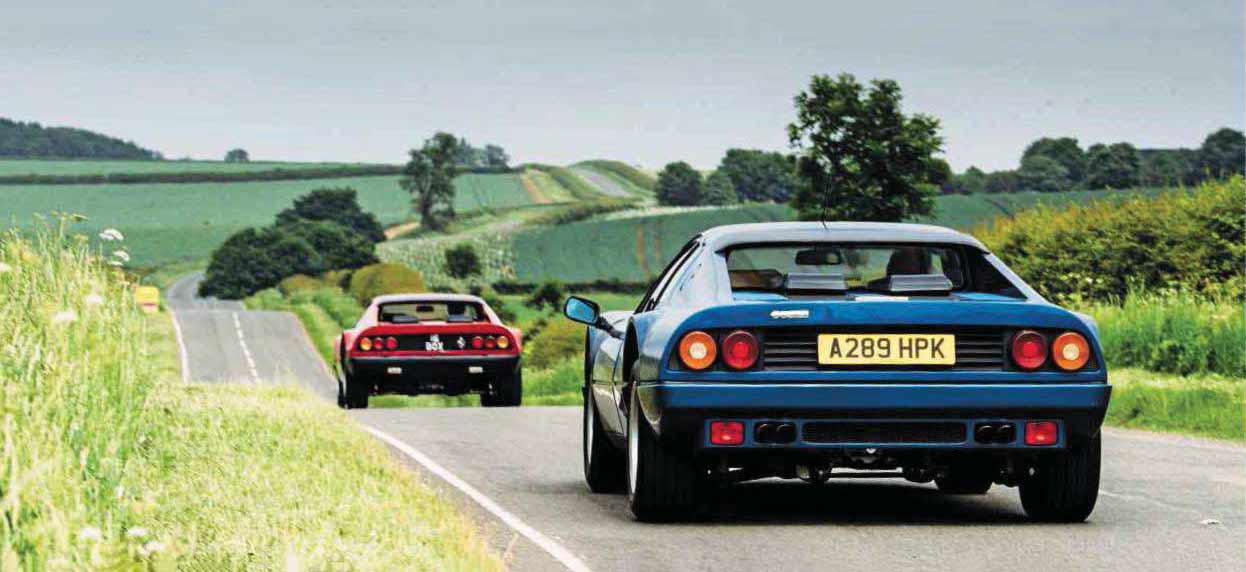
Then the pressure of exhaust emissions began to bite, and it was goodbye to the slurping Webers after 929 512s (128 of them in right-hand drive) had left Maranello. In the Webers’ place came, from 1981, Bosch K-Jetronic continuous fuel injection and a pair of plenum chambers leading to swirlingly curved inlet manifolds and a small drop in power to 345bhp. That was still plenty, especially as the same peak torque now arrived at slightly lower revs where it would be more useful. Michelin TRX tyres on metric rims were another innovation.
This final Boxer, the 512i, ran to 1984, upon which the new Testarossa took over. In the mood of 1980s optimism, the 1970s energy crisis forgotten, the 512i became the most numerous of Boxers with 1007 made, albeit only 48 in right-hand drive. That makes our metallic blue example a very rare machine.
Two of these cars have been on magazine covers before. Stephen and Daniel Gannon’s 365 BB, smoulderingly understated in dark Bordeaux Red, featured on the front of Autocar 10 September 1977, driven at night by a mystery helmet-clad man, gazed at by an adoring woman. The 365 was a year out of production by then, and this one was three months away from its second birthday, but it signalled a feature inside whose star was unavailable for the cover shoot. In those days, a colour cover had to be printed well in advance of the monochrome pages inside.
Featured in that monochrome was a then-current 512 BB, registered OPC 86R. It was pale metallic blue, Maranello Concessionaires’ demonstrator as displayed at the previous year’s Earl’s Court motor show, and the very first right-hand-drive 512 BB. It had its own Autocar cover-shot glory earlier in the year, 9 April 1977 for a ‘sports-car special’ at Prescott hillclimb, and it’s the same 512 BB – somewhat modified, and in a new hue – that’s with us today Ferrari specialist Bell Classics, which has the 512 for sale, is hoping to get the registration number reinstated; it went off the radar during the BB’s 26-year stay in an Austrian collection.
The chance links of history continue with our 512i, lent to us by Ferrari specialist, and former main dealer, Rardley Motors. It’s one of two BBis in its showroom, both right-hand drive and representing an impressive proportion of the total RHD 512i population. It was Rardley Motors that looked after the Gannons’ 365 in its first years, including the time of its cover-shot glory
So, the scene is set. First, the 365 BB, freshly restored and taking to the road today for the first time since it was finished. Much of the work has been done by Ferrari expert Geoff Shilton at Shiltech, but father and son Stephen and Daniel – they run classic, high- end, fast-car dealership Car-Iconics – have also made use of other talents they have got to know, such as the man who coated the body in its deliciously smooth and shiny paint.
It seems to sit high on its wheels, the arches gappy That’s how they were, although the lower-profile tyres worn by all three cars (the original sizes, as listed in our specification panels, being hard to find) emphasise the impression. Would making it sit lower make it feel less precarious” That’s the reputational baggage niggling away again. Maybe it doesn’t actually feel precarious in the first place. Certainly there was no mention of a Boxer’s precariousness in those Autocar stories.
Actually, you wouldn’t want it any lower. Once you’re snug in the black leather seat with its oh-so- Italian transverse ribs, your head is no higher than the top of an SUV’s tyre. Put that contemporary thought out of your head as you savour this 1970s cabin free of Fiat-sourced switchgear, Momo Prototipo steering wheel ahead, slatted silver speaker grilles to each side, red-figured instruments cowled in shallow tunnels, giant ashtrays in the sills. And, of course, a slender, gently cranked gearlever emerging from the expected open gate and topped by a shiny black sphere.
It’s amazingly airy in here, what with the low scuttle, the thin windscreen pillars, the deep side windows and an unexpectedly clear view aft. This is a key ingredient of the way the BB feels smaller and handier than you might have anticipated; it seems barely bigger than its 308 contemporaries.
Maybe there are Italian genes buried within my DNA, despite my assumption of a broadly Celtic genetic dominance, because I fit the Boxer perfectly Taller people berate the offset pedals and steering wheel, the interference of knees with Momo, the lack of thigh support, the excessive stretch needed to reach the top of the raked wheel-rim. But it all works for me, the only snag being the effort required to bottom the clutch pedal.
This I must do, because a clean gearshift depends on it. And as long as I do what is needed, the changing of gears is a quick, metal-on-metal snick requiring only a wrist primed with a suitably heavy preload. I can’t use many revs on this potentially very revvy engine because it has covered almost no miles and its brand-new pistons are still bedding into their brand-new liners. Not to worry; I can still feel how the Boxer moves along the road, how light and direct its steering is, with a clearer, crisper response around the centre than Ferrari’s first mid-engined road car, the Dino.
It kicks back a bit, too, and the brakes have a long travel. Is that how it’s supposed to be, or is there alignment to do, brake pads to bed-in? I’ll reserve judgement on these BB characteristics while I savour the tenor blare of the 12 cylinders, the whine of the gears en route to the cambelts’ drive, the busy fizz of valvegear, all those much-written-about Ferrari sounds that are no less enthralling for having heard them, and read about them, before.

I dive into a bend as fast as I dare, slowing from the 5000rpm Daniel is now permitting, a speed at which the engine is starting to sound really interested. Am I aware of a heavy weight behind my shoulders, in danger of triggering a top-heavy lurch like that of an overloaded truck? No. The Boxer just sits firmly on its outside rear wheel as I turn, pushes its nose slightly wide as I accelerate, counters that with a growing slip-angle at the back as I accelerate a little harder. All just as you would expect in a mid-engined car.
NOW, THE 512. Quite apart from the Koenig makeover on this particular example, there are changes from the 365 beyond those outlined earlier. The rear grille is formed from slats rather than slotted sheet metal, and the rear clamshell’s shutline jinks forward towards the door a little so it can mimic the next shutline along. And in this case, under the extended arches are Pirelli P7s of very 1980s-supercar dimensions: 205/50 at the front, 345/35 at the back, still on 15in rims.
Also, the airboxes over the carburettors have been ousted in favour of air-scoops reaching to roof-level, with no air filters to protect the very visible intake trumpets. Here is the Boxer as 1980s-flavour hot rod, the engine converted with an ‘LM Specification’ kit by Ferrari agent Emblem Sports Cars for £8212.92 when the 512 was 14,810 miles old. The kit includes hotter camshafts, and in peak health the engine should produce a good, genuine 380bhp, maybe even 400. But not today
Certainly it takes off with a whipcrack ferocity, howling round the tachometer’s scale with a hard, open-mouthed assault from the intake trumpets that a meagre glassfibre bulkhead can’t really smother. Nor can it absorb the whistles and whines from the old- school electronic ignition pack. It’s frantic in here, goading me to go ever faster if the engine, long dormant, would only give its all. But it does heighten the sensation felt earlier in the 365 of amazing deftness and agility It feels far smaller than a Testarossa.
Two key attributes amplify the deftness. First, the clutch is acceptably light, which massively helps the precision and speed of my gearshifts. Second, slightly ridiculous as those fat, squat wheels look, they fundamentally change how the Boxer handles while still allowing it to ride with surprising suppleness.
It turns-in like a modern Ferrari: instant bite, no springiness, no kickback, and it grips hard with no suggestion of a wavering, squidging tail. It just hunkers down and blasts onwards, always friendly, never threatening, insidiously addictive. It’s amazing what optimum tyres can do, even when they look wrong. Pity about the long-travel brakes, though, again. They surely shouldn’t be like this.
NOW I’M IN THE 512i and no, they shouldn’t. It has terrific brakes, a firm pedal, lots of bite, just as you would hope for in a 12-cylinder supercar. It also has an engine that, unlike the other two, is clearly employing the full cylindrical dozen all the time with a wailingly crisp exhaust note to prove it. Maybe that’s down to the injection, maybe a recent £12,000 overhaul.
Here is the Boxer honed and fettled as its creators intended, with the plumpest torque curve and a riotous encore from the exhausts each time the red line approaches. It’s a brilliant thing, marred only by a savagely, toe-crunchingly heavy clutch, which the twin- plate design shouldn’t be. Its tyres are new TRXs but, again, not in the original sizes: these have a lower, 55- per cent profile and are the same size front and rear, instead of presenting more rubber at the back.
That, and the abundance of power, make for another variation in the Boxer’s dynamic signature, one which comes closest to the folklore. It’s softer in its responses than our carburetted 512, rides even more smoothly, and you can feel it moving around on those rear tyres as the power comes and goes in a bend. If you unsettle it by lifting off after hurrying into a corner, you can indeed feel that weight wanting to head off in its own direction behind you and take the rest of the car with it, but – at least on the dry roads of our driving day – it settles as soon as you reinstate the power to the rear wheels.
With the masses marshalled, working with you when you need them, a Boxer is a beguiling drive. Clearly it’s better with bigger tyres aft, as Ferrari itself found, and thus-equipped it’s a car of rather more sophisticated attributes than I’d imagined. I got closest to the full Boxer experience in the lovely BBi, with working air-con and a fabulously ’80s Pioneer stereo to help set the tone, aurally as well as ambiently. And it was joyous.
SHOULD YOU BUY a Boxer” Just finding a really good 365 is difficult, although Car-Iconics does have another which used to be owned by Sir Elton John. The 512s are slightly less uncommon, and ultimately they are all about as fast as each other in standard form. You might favour a 512i for its slightly less ruinous fuel economy and tidier engine management, a 365 for its first-of-the-breed purity, a 512 for its blend of both extremes.
All cost around ten times their prices when new for a good one. All will have had many thousands spent on them over the years, and that expenditure will continue even if you don’t use your Boxer much. But you probably know all that. What I’ve discovered is that the Boxer is a machine of unexpected brilliance that has, perhaps, been unjustly overlooked. Handier than a Testarossa and less burdened by visual excess, it’s a hidden gem. Maybe, if you have a quarter of a million to spare, it’s time to rediscover the BB’s charms.
Many thanks to: Bell Classi s for the 512 (above), Car-lconics for the 365, and Rardley Motors for the 512i.
Tech and photos
‘WITH THE MASSES WORKING WITH YOU WHEN YOU NEED THEM, A BOXER IS A BEGUILING DRIVE’
TECHNICAL DATA FILE SPECIFICATIONS Ferrari 512i BB
ENGINE Flat-12, 4942cc, fuel injection
MAX POWER 345bhp @ 6200rpm
MAX TORQUE 330lb ft @ 4200rpm
TRANSMISSION Five-speed manual, rear-wheel drive
SUSPENSION Front: double wishbones, coil springs, telescopic dampers, anti-roll bar. Rear: double wishbones, dual coil springs and telescopic dampers, anti-roll bar
STEERING Rack and pinion, unassisted
BRAKES Vented discs, 290mm front, 295mm rear
WHEELS 7.5 x 15in front, 9 x 15in rear, alloy
TYRES 215/70 VR15 front, 225/70 VR15 rear
WEIGHT 1580kg
POWER TO WEIGHT 222bhp/ton
0-60MPH c5.5sec
TOP SPEED 180mph+ (claimed)
PRICE NEW £39,991 (£163,000 in today’s money)
VALUES TODAY £225,000-£300,000
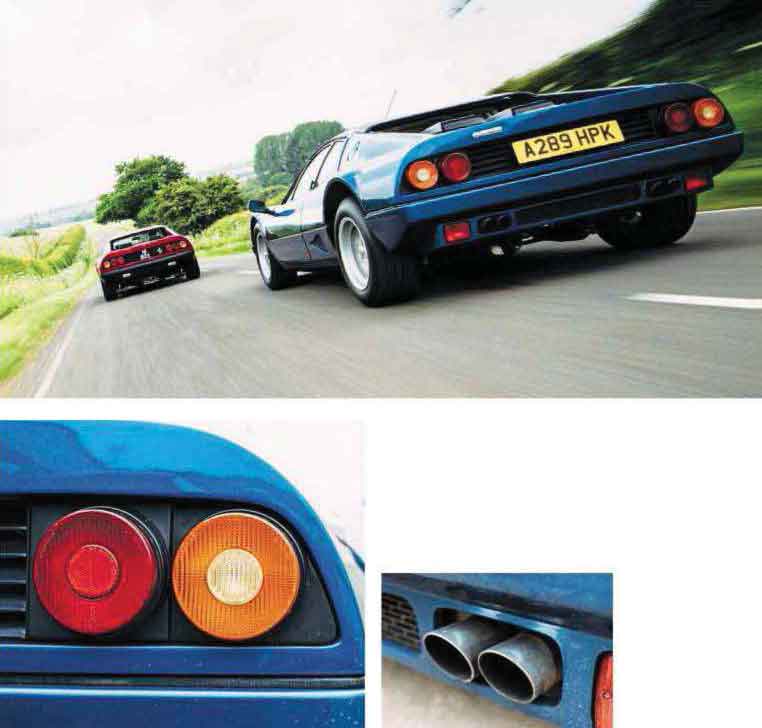
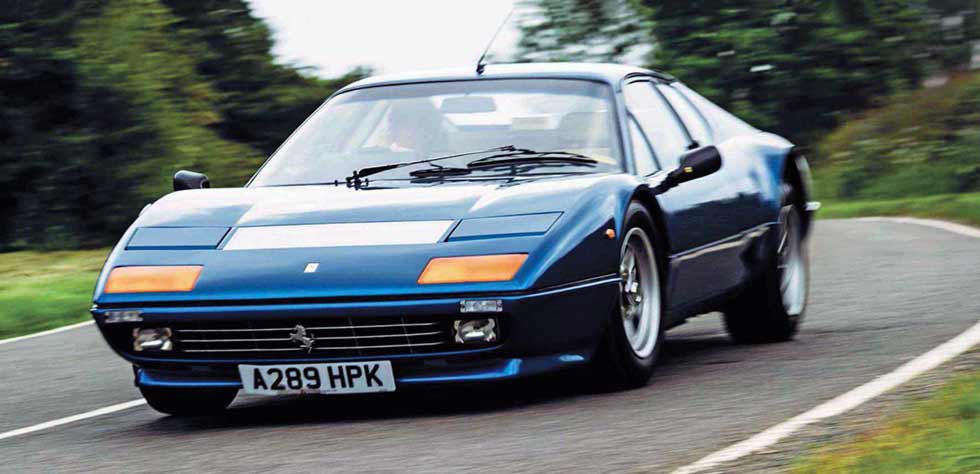


‘HERE IS THE BOXER HONED AND FETTLED AS ITS CREATORS INTENDED’
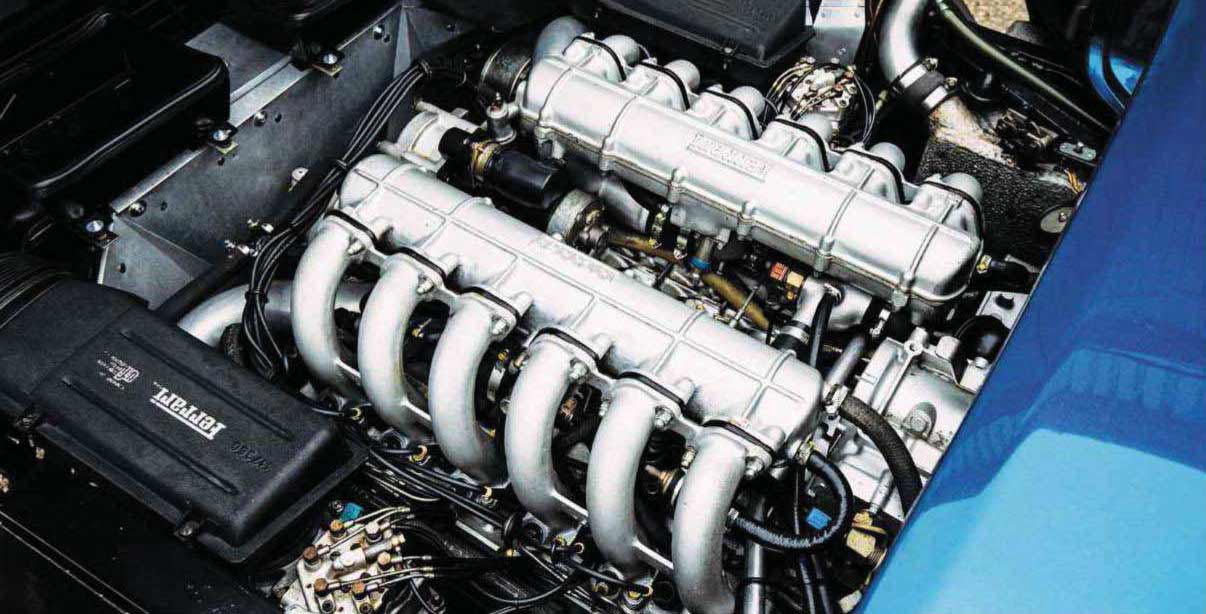
‘PRESSURE OF EXHAUST EMISSIONS BEGAN TO BITE
TECHNICAL DATA FILE SPECIFICATIONS Ferrari 512 BB (standard car)
ENGINE Flat-12, 4942cc, 4x Weber twin-choke carburettors
MAX POWER 360bhp @ 6200rpm
MAX TORQUE 330lb ft @ 4600rpm
TRANSMISSION Five-speed manual, rear-wheel drive
SUSPENSION Front: double wishbones, coil springs, telescopic dampers, anti-roll bar. Rear: double wishbones, dual coil springs and telescopic dampers, anti-roll bar
STEERING Rack and pinion, unassisted
BRAKES Vented discs, 288mm front, 297mm rear
WHEELS 7 x 15in alloy T
YRES 215/70 VR15
WEIGHT 1515kg
POWER TO WEIGHT 241bhp/ton
0-60MPH c5.5sec
TOP SPEED 180mph (claimed)
PRICE NEW £26,450 (£157,000 in today’s money UK)
VALUES TODAY £225,000-£300,000
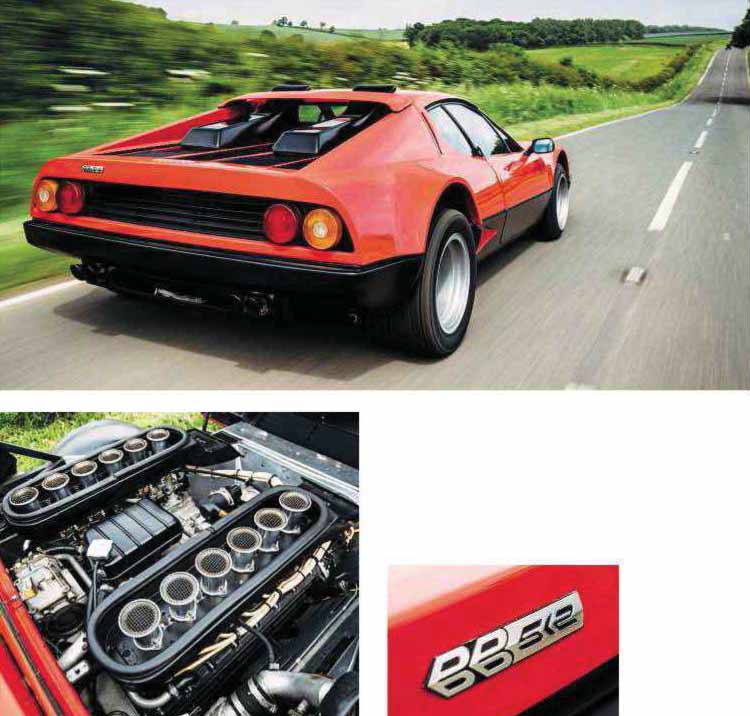


“THE STEERING HAS A CLEARER, CRISPER RESPONSE THAN IN THE DINO”
‘MOTOR’S TEST CAR RECORDED 11.1 MPG. A LOT OF FUEL WAS SUCKED THROUGH THOSE WEBERS’
TECHNICAL DATA FILE SPECIFICATIONS Ferrari 365 GT4 BB
ENGINE Flat-12, 4390cc, 4x triple-choke Weber carburettors
MAX POWER 344bhp @ 7200rpm
MAX TORQUE 302lb ft @ 3900rpm
TRANSMISSION Five-speed manual, rear-wheel drive
SUSPENSION Front: double wishbones, coil springs, telescopic dampers, anti-roll bar. Rear: double wishbones, dual coil springs and telescopic dampers, anti-roll bar
STEERING Rack and pinion, unassisted
BRAKES Vented discs, 288mm front, 297mm rear
WHEELS 7 x 15in alloy
TYRES 215/70 VR15
WEIGHT 1550kg
POWER TO WEIGHT 225bhp/ton
0-60MPH c6.5sec
TOP SPEED 175mph (claimed)
PRICE NEW £15,492 (£155,000 in today’s money)
VALUES TODAY £275,000-£375,000

Below, left and above First of the breed: 365 BB distinguished by black lower bodywork, and also by triple rear lights at each corner (with matching triple exhausts below). Cabin is airy, with a great view out in all directions.
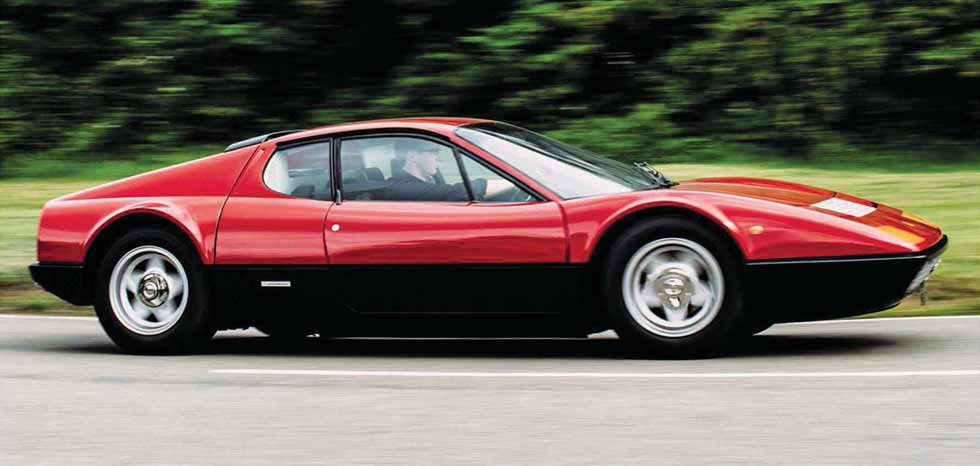
‘THE BB FEELS SMALLER AND HANDIER THAN YOU MIGHT HAVE ANTICIPATED, BARELY BIGGER THAN A 308’

‘STRANGE THAT THE BOXER IS SOMETHING OF A FORGOTT EN FERRARI’
UNDER THE SKIN
The very first right-hand-drive Berlinetta Boxer is being restored by a British enthusiast. It’s a rare opportunity to see a BB laid bare. WORDS JOHN SIMISTER. PHOTOGRAPHY TIM ANDREW.
Usually, when we major on a particular Ferrari family, we include the story of its engine, how it is constructed, how it was designed and developed. For this issue’s exploration of the Berlinetta Boxer breed, though, we’re doing things differently. That’s because, during our research, we were led to the very first right-hand-drive Boxer to be built, which is now being rebuilt, slowly, by arch-enthusiast Nick Buist.
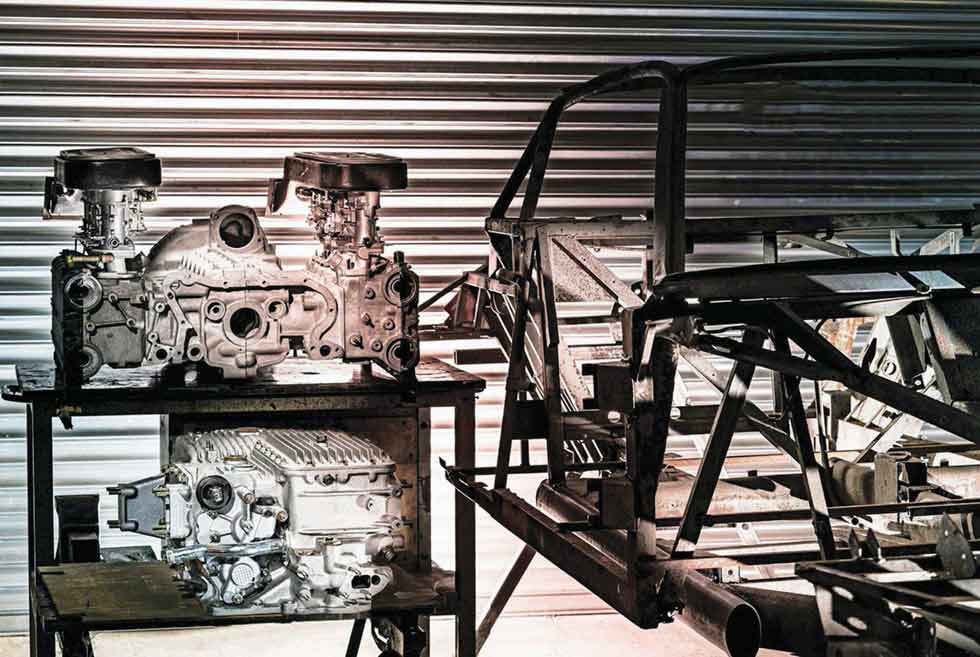
It’s the inside of his barn that you see here, containing not just his 365 GT4 BB’s engine (in pieces) and gearbox (freshly rebuilt) but also many of the body panels (some new), lots of fixtures and fittings and, in all its naked tubular glory, the chassis. A Boxer’s bare bones. How could we resist”
‘I bought it with about 30 per cent of stuff missing, including the engine,’ begins Nick. ‘Then I found the original engine in St Albans through the Ferrari Owners’ Club magazine. “Don’t sell that to anyone else,” I said, “because I have the car.” I probably shouldn’t have said that, because it didn’t improve my negotiating position.
‘All the bits on it, the fuel pipes and so on, lined up exactly with what I had. It was spine-tingling.’
When Nick found his Ferrari, it was under a tarpaulin in a garden. ‘I’d been a Ferrari apprentice, and I knew I could feel for corrosion in the chassis outriggers through the ashtray apertures in the sills. This one was corroded. Now it’s stripped to the chassis, which was really badly made by Scaglietti. It’s been checked by laser so I know it’s straight, but it’s had a few knocks.
‘The car was metallic blue originally and will be again, but I confess I did paint it red when I got it 16 years ago. I would sit in it regularly and imagine the engine sound…’
To look at the chassis is an education in pragmatic construction. Tubes abut tubes and are held there by welds instead of being slotted into size-matched orifices. Jagged edges abound, and we get a clear view of the favourite corrosion spots, which Nick is working through, including those main side tubes with their oval cross-section.
Yet, for all the apparent cottage-industry crudity, it’s a strong chassis. Restoring it, cladding it with body panels and fitting all the mechanical parts is going to be a deeply satisfying task. ‘I think I’ve got about 90 per cent of the parts now,’ Nick declares. So when will the Boxer be finished” On that, he will not be drawn.
And then there’s the engine. Look in a Boxer’s engine bay and the flat-12 seems a huge chunk of metal, somehow bulkier than a same-capacity V12 because it’s so wide. Out of the car, it’s even more imposing.
Partly this is because it sits relatively high, on top of the gearbox, which nestles next to the wet sump in a 365 (the 512 has a dry sump, as does the Testarossa that supplanted it). Drive is transmitted from the clutch, via an idler gear, down to the gearbox input shaft, which points forward, passing over the differential, to meet the gearbox itself ahead of the rear wheels. The gearbox casing and the sump are one big aluminium casting, but divided so engine and gearbox have their own separate oil supplies.
A key reason for Ferrari’s introduction of a roadgoing flat-12 was that its F1 cars were using that configuration from 1969, with considerable success, in the 3-litre 312B and its descendants. That was a Mauro Forghieri design, as was Ferrari’s first flat-12 – a 1.5-litre F1 unit used in 1965. There was a 2-litre sportscar unit in 1968, too. Clearly there was much marketing capital to be made in transferring racing ideas to a road car.
The other major driving force for this powertrain was compactness. To have placed the engine ahead of the gearbox, as in many a mid-engined sports-racing car, would have required a longer wheelbase or eaten greatly into cockpit space. But with the gearbox under the engine, the crankshaft is almost two feet above ground level so the flat-12 layout is vital to keeping the centre of gravity manageably low.
The roadgoing motor, designed by Giuliano de Angelis, clearly took its racing predecessors as its inspiration but was significantly larger at 4390cc. That capacity, the bore and stroke and even the pistons and connecting rods were as used in the Daytona’s V12 engine, but one new departure was the use of toothed rubber belts, one per bank, instead of chains to drive each bank’s pair of overhead camshafts. A crankshaft gear drove adjacent gears, again one per bank, which shared their shafts with the timing belts’ driving sprockets.
In other respects, the engine featured familiar Ferrari technology, albeit with a 180° ‘vee’-angle rather than the usual 60° of the time. Which leads us to a small controversy in definitions, given this engine’s Boxer branding. A true ‘boxer’ motor has its opposite pistons moving in opposition to each other, both reaching bottom dead centre or top dead centre (to use vertical- engine terminology) at the same time. That, clearly, requires separate crankpins spaced 180° apart, and a slender crank-web between them, but to do this makes for a longer crankshaft and a bulkier motor.
So, as with the V12, opposite pistons’ connecting rods share a common crankpin. This means that when one piston is at the top of its stroke, its opposite is at the bottom. It makes for a more compact engine, if a fractionally less smooth one because mechanical reciprocating forces aren’t being directly cancelled out, but no-one could ever describe a Ferrari flat-12 as rough even as it heads past 7000rpm. The left bank sits a con- rod’s width further back than the right bank.
Typical Ferrari design features are tappet shims set on top of the bucket tappets, for easy removal and replacement and therefore valve- clearance adjustment, a separate distributor for each bank driven from the aft end of the inlet camshafts, and cast iron wet cylinder liners. The block/crankcase in which they sit is split vertically into left and right halves.
As a 365, the engine has slightly oversquare bore/stroke of 81/71mm. Enlargement for the dry-sumped 512 made the dimensions close to square, unusually so for a Ferrari, at 82/78mm. Both were fed by four triple-choke downdraught Weber 40 IFC 3s, but that changed with the 512 BBi, which used a stereo pair of Bosch K-jetronic continuous injection systems resulting in big improvements in fuel economy and emissions. As for power, all three versions made something between 340 and 380bhp, depending on who you believe; even Ferrari couldn’t agree with itself in its technical literature.
This two-valves-per-cylinder family of BB engines, dubbed F 102 AB by Ferrari, was in production from 1973 to 1984. It was then heavily revised for the Testarossa, which itself evolved into the 512TR and 512M, with four valves per cylinder, shrink-fitted and Nikasil-coated aluminium cylinder liners, and cambelts driven directly from the crankshaft. The result was 390bhp at 6300rpm and 362lb ft of torque at 4500rpm, delivered cleanly and with a fuel efficiency unimagined in the 365 BB’s early days. All that, and red camshaft covers too… but by 1996 it was all over for the flat-12.
Will we see a Ferrari flat-12 again” It’s unlikely, but it would be a welcome dose of mechanical variety. As it is, Ferrari remains number one in roadgoing flat-12s. In a field of one.
“OUT OF THE CAR, THE BOXER ENGINE IS EVEN MORE IMPOSING”
‘FOR ALL ITS APPARENT COTTAGE-INDUSTRY CRUDITY, IT’S A STRONG CHASSIS’
Below and left Nick Buist in the barn where he’s restoring his 365 GT4 BB. One of his biggest tasks has been ridding the tubular steel frame of corrosion. Above and right When Nick bought the car, it was without its original engine, but chassis and engine are now reunited and slowly coming together. Flat-12 looks bigger than equivalent V12, despite same internal dimensions. Fuelling is via a quartet of Weber 40 IFC 3s.
Top and above The gearbox nestles next to the wet sump in a 365, the gearbox casing and sump forming one big aluminium casting, but divided so engine and gearbox have their own separate oil supplies.
12 over 24 FEATURE BBS AT LE MANS
The Boxer made a charismatic endurance racer, as Mark Hales discovered when he got a chance to drive this 512 BB LM in the Le Mans Classic. PHOTOGRAPHY JEFF BLOXHAM (LE MANS) & TIM ANDREW.
There are so many exciting things about the Circuit de la Sarthe. The hugely fast dive off the main road onto the infield, followed by the sequence that makes up the Porsche Curves. The two chicanes along Les Hunaudieres where the braking is so hard to judge, especially at night. The swerve up to the Dunlop Chicane after the pits that’s so tempting. And, of course, the gladiatorial streak past the amphitheatre of grandstands and pits where the noise reverberates off the walls and pours back into the cockpit.
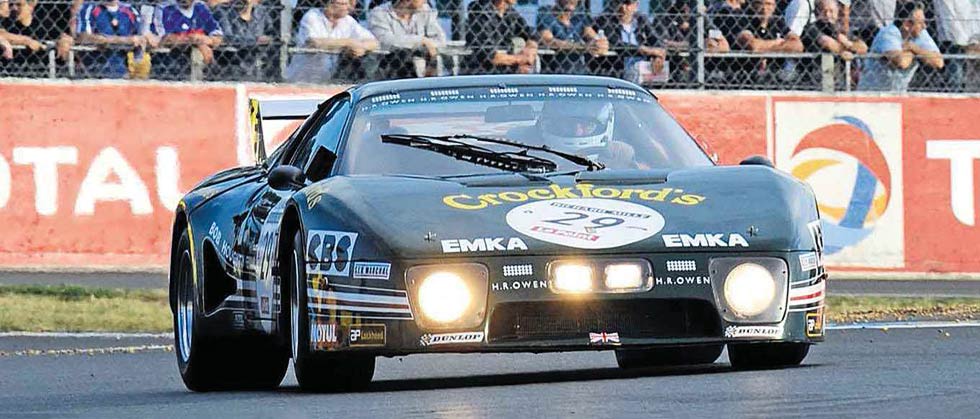
Until I drove it, it was just a place of legend. Now it’s like a drug. After every visit, every lap, the next one absolutely has to be better. I can definitely brake later for the chicanes, take more speed towards the Mulsanne corner and into Indianapolis; remember not to pinch the last entry at the Porsche Curves; use more kerb on the Ford Chicanes…
But it’s the plunge into a sometimes oil-slicked night along the kinked road joining Mulsanne to Indianapolis that stands out. It remains one of the most exciting things I’ve ever done in many years of motorsport.
For most of the year, this stretch is just a piece of rural French road, a tree-lined way to work or play for the locals, which you’re welcome to drive any time you like. In daylight you’ll barely see the rise about halfway along, just where the road bends so gently to the right; you might overlook that it’s just steep enough to hide the roof of a car coming the other way. No matter, for most of the year there’s a line along the middle to keep you separated. In the pitch darkness of a brief June night, behind the wheel of something that needs absolutely every centimetre because there’s five litres or more behind you but no wings to push everything down, it all seems so very different.
The corridor between the trees either side of the cockpit closes in like a tunnel, a grey-green, grey-black blur flashing by in the periphery of your vision. A glance tells you there’s barely any run-off area, just a small piece of verge, then Armco, then trees. The speed somehow shrinks the road, brings them so close that you could surely reach out and touch the leaves. And still you can have no idea what lies beyond the crest.
The clerk of the course put it so succinctly during the briefing. ‘If you are afraid to drive at night,’ he said, ‘then please stop. Don’t do it.’ He’s right. If you lift your foot along that stretch of the D140, there’s no point doing the event. That’s why you go. To taste the freedom of ridiculous speed on a public highway, sample a unique aspect of a road that’s so long but still only a fraction of the whole. And having made the decision, all you can do is aim the nose and stare into the gloom beyond the four yellow pools that light the road ahead and hope there’s nothing parked.
Something like a 512 BB LM, though, makes the decision easier. Squeeze the steering wheel’s chunky rim and aim the nose somewhere way out of sight. Feel the almost leisurely heave in response to the command, almost more than you expect for a steer that’s little more than a thought. Easy to overlook how fast we’re travelling. Then, as the road rises and falls, we float over the crest as if the earth beneath has become a living swell. One corner, then the rest, and then the tail.
Now everything settles as the last piece of road comes sweeping to meet the left-front wheel and the steering stops its little fidget, which says the corner that isn’t and the crest that wasn’t have both passed beneath…
It was just beyond that same rise at the Le Mans Classic in 2008 that the BB – which had seemed so friendly and so nice and easy to drive – chose to seize a front wheel-bearing, which then exploded to leave the wheel flapping like a landed fish. The car’s mass had ensured only staying power could edge it towards the podium in 1979; now it turned right and headed towards the barriers, then thought better of it. There wasn’t much I could have done. The fact that it happened in the dark at about 170mph, and that I didn’t hit anything, was in the lap of the gods – that and perhaps the specification that the Ferrari ‘Customer Service’ department had contrived to suit wealthy buyers in independent teams.
Nick Mason’s 512 BB LM, chassis no 27577, is a survivor of the 1979 and ’80 events (it finished a very respectable 12th in 1979) and one of only 12, supplied new to long-serving Belgian customer team Ecurie Francorchamps. The LM used the road car’s fuel-injected 4.9-litre flat-12 engine, lightly modified to push out about 400bhp at 7200rpm. The longer nose and tail were conceived to smooth the airflow and keep everything stable down the longest of straights (Ferrari and Porsche had both learnt from Lola here), and there was slightly stiffer suspension plus wider arches to cover much wider rims.
Built for stamina rather than outright speed, it’s a heavy old lot, tipping the scales at nearly 1200kg and this, together with wide ratios in the road car gearbox, makes it feel less like a racer than some, but it’s relaxed and friendly, much more so than the road car on which it’s based. That long nose and tail – and a set of huge slick tyres – spread the envelope wide enough to contain power and speed that seem modest by comparison with the works racers of a decade earlier.
I had driven the car a few times before we set off for the Le Mans Classic all those years ago, so I already knew that the heavy metallic bark from those four pipes, poking out like shoots in search of light, was worse than the bite. It didn’t howl like a 512S’s V12; it was more of a crackly, braying sound. I’d learnt to anticipate the car’s mass, make the steering input progressive and early and get the car leaning on its laden wheels sooner in the turn – you couldn’t hurry it and you couldn’t scrap. Try to hussle and the front end would wash wide, so you needed to be smooth, which was probably just as well because those big tyres made for heavy steering and a need to use arms and shoulders rather than a flick of the wrists.
Meanwhile the mass of transfer gears and hefty internals, with a set of ratios that spanned a theoretical 188mph top speed, gave the synchros a lot of work to do if you used the full 7000rpm, so you couldn’t hurry the gearshift either. The synchros are tough, though, and should you be tempted to rush things, they would block you out and bruise the palm before shedding any teeth. The gaps between the gears might also occasionally tempt you to select a lower one in search of more acceleration and then have to shift in the middle of the corner, a strategy that always took longer than tickling the pedal and waiting for the cams.
The 24-hour track at Le Mans must be the only one in the world where the straights are almost as exciting as the bends. Some of it’s the camber of public roads curved to drain water, a detail that would spook the drivers as their cars edged beyond 200mph at the end of the 1960s: Brian Redman is on record after his first outings in the 917 with the shorter tail, saying the bloody thing would use all the width of the track without any input from him. But it’s also the way you get to top gear so early on and then hold it for an age, listening to the revs creeping up, 100 or so at a time. That and feeling for any vibration, any sound or smell, anything that doesn’t seem normal. I drove Nick’s 512S there and it would get to 170 or so and then just hold back as if some invisible hand had grasped the car. It always felt as if it was starved of fuel because the engine was working so hard, but it was just the air clawing at the bodywork.
And then as the chicanes began to fill the screen – over to the left for the first one, keep right for the second – you had to be so careful with the brakes. It’s a common factor in cars like this – use them hard for even a lap and the BB LM’s pedal would grow longer and you’d end up having to pump it at. Must have been the same for the good guys in period, so how did they manage it? It’s something I’ve asked myself many times. Tread too hard and you’d have no pedal; too little and you’d be giving speed away
There was, too, the question of oil pressure. The BB’s flat-12 engine was dry-sumped, had to be because of the layout, so why did the needle dip to zero at a Silverstone shakedown and stay there for seconds? I came straight in to see if someone had forgotten to fill up the tank, but no. Bob Houghton, who ran the car in the 1980 race, said it did exactly the same in period, and Ferrari had said not to worry I asked Geoffrey the engine-builder for a second opinion. He took one look at the tank and said they couldn’t have designed anything better… if they were looking to promote oil-surge. He drew a quick sketch and said to try that, adding that we’d find something similar on any Lola or Chevron. The alu-wizards swiftly stitched one together and the needle has never moved since.
There were all the essential rituals beforehand, too, like the workout that was lifting the massive tail and propping it on the bespoke stay so that Ben or Charles could clamber beneath, remove the airboxes and squirt neat petrol into the intakes while I sat in the cockpit and cranked the engine via a regular ignition key – complete with prancing horse fob. And then I would look up to see the attendant crowd, ears covered to keep out a wall of sound unlike anything else, all enraptured by the whole performance. It was a stage and I was just fortunate to be the player.
The first Classic, I drove the car with Nick – a veteran of five Le Mans races in the 1970s and ’80s – but the wheel-bearing incident meant we didn’t finish. By 2014, Ferrari garagiste Bob Houghton had turned racer instead of mechanic and suggested we tackle the Classic once again and that he’d already asked if we could borrow the BB LM and that Nick was fine with the idea. Nick was busy that weekend though, so maybe Mark would like to sub for him.
Naturally, I jumped at the idea. The car would go back to the hunting ground for which it had been designed and Bob would be driver instead of engineer. It would be like putting the band back together.
And so the car and I duly found ourselves back at the Classic, which had become busier than ever, and the four races slightly shorter. My first outing turned out to be a touch frustrating – out came the pace car early on and it stayed out, so that was that. It’s one area in which the event has become a victim of its own success. Still, there was the night stint to look forward to, for which the grid would assemble under floodlights down on the Bugatti circuit, an hour beforehand.
There’s something special about the sense of occasion at this hour. It was about 1:30 in the morning and a long row of time-served Le Mans veterans sat waiting. The anticipation of what we were all about to do, which is to dive into a black void and travel well beyond three figures on a public road, hung in night air that was chill but above ground that was warm, in that uniquely European way. Breath steamed under the lights as we made small talk to while away what seemed like an age of waiting.
And then it began to drizzle. On the car was a set of wide Avon slick tyres. Bollocks. Was it worth changing” There was no information to make any kind of sensible decision. Ben and Charles could maybe have brought the wets down in a Jeep but they were back up in the pits and I had no way of contacting them. And more to the point, was it the right thing to do” Just how wet was it”
I decided that, if it didn’t get any worse, then slicks would be fine. Wets wouldn’t last, and besides, I had the weight and wheelbase of a BB LM on my side. Think of it not as a problem but as a potential bonus.
Now the wait seemed to be over too quickly Marshals waved their arms, engines were fired up and we were shuffled onto the track, where we trundled round on the pace-car lap while I tried to create some space to experiment. Hold back. Don’t lock the front wheels. Open up the entry to the turn and roll the car in with a bit more speed than feels right, then let it lean on the front tyres. Let the car finish the job and see how much grip we’ve got. And be patient. Get the car straight before treading the pedal. Spin- up rears that wide and you risk going skating. But… it felt good. There were others around me clearly less comfortable so I began to get that glorious feeling of confidence that comes when you feel you have an advantage.
Sadly, I wouldn’t get the chance to take it. I was already threading my way through the prototypes when the pace car came out again. Something had happened elsewhere on the 13.629km and we were back to what felt like walking pace. But in the end it didn’t make any difference and, as the drizzle turned to lashing rain, even the 512’s weight and wheelbase were no help. One minute I was rolling it confidently through Indianapolis and Arnage, the next I was gritting my teeth as the nose washed straight towards the grass at the Porsche Curves.
Wouldn’t have been so bad if, later in the day, Bob hadn’t enjoyed an uninterrupted run in glorious sunshine. Not that I wish him ill, of course. Le Mans. however you get on, you will always feel the need to go back and have another go. Unless, perhaps, you’re Nick Mason. Sometime on Sunday afternoon, I received a text message. ‘Like Enzo,’ it read, ‘I sit at home and wait for news of my cars.’
‘As the drizzle turned to lashing rain, even the 512’s weight and wheelbase were no help’
‘It seized a front wheel bearing, which exploded to leave the wheel flapping like a landed fish’
‘Until I drove it, Le Mans was just a place of legend. Now it’s like a drug”
Below and left Hales back with the car he’s raced twice in the Le Mans Classic – with mixed but memorable results.
Above and top Owned today by Nick Mason, chassis no 27577 still wears the livery from its second Le Mans outing in 1980. Heavily revised bodywork of the 512 BB LM was designed to promote high-speed stability on Le Mans’ epic straights. Above and right This Ferrari 512 BB LM raced at Le Mans in 1979 and 1980. It’s pictured here in the 2014 Le Mans Classic.


